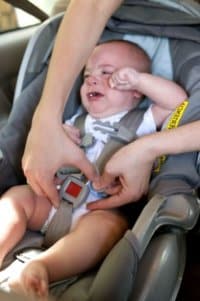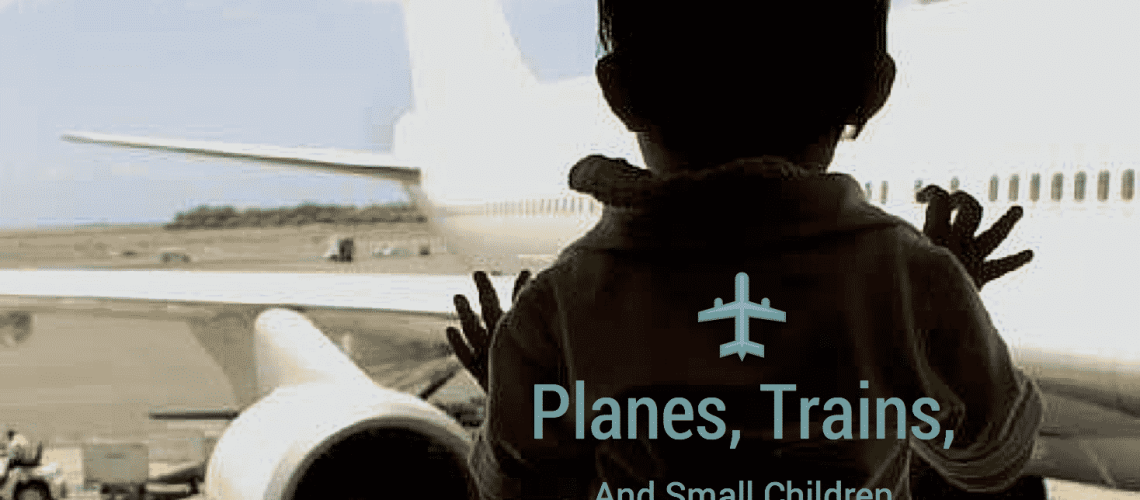Q. I'm wondering if you have some sage advice about dealing with our rambunctious 2 year-old on a transatlantic flight in a week. My son is very physical and very loud in his crying, and I'm dreading the potential tantrums and inevitable shorter crying in such a small space!

There’s a reason why so many young children have extended hearty cries on an airplane! Physical closeness and attentiveness sends strong signals to a child’s emotional center. The signals say, “The closeness that you crave is here, right now! Enjoy!” And if a child’s feelings have been listened to recently, and often, then the child enjoys the closeness, and can sleep, or find a variety of ways to amuse himself.
But most little children have loads of unheard feelings stored up, and those feelings sit like carbonation in a bottle of sparkling water. You can’t see the bubbles, but when you pry off the cap, they fizz mightily, a force to be reckoned with!
Your presence engages a healing process in your child.
Your presence as you sit, strapped in and close by, pries the cap off any stored feelings your child has. His mind dearly wants to absorb your presence, but unpleasant feelings are aching to be heard! The longer you sit, the more likely it will be that your child’s proximity to you will nudge those feelings to the surface, so he’s driven to cry or tantrum or struggle as he heals from some hurt from the past. The thing he begins to cry about will be a small or a provocative issue: wanting to pull off your buttons, suddenly trying to hit your face, or wanting to bang his feet on the seat in front of him. When you set a kind but definite limit, the healing begins.
Crying, tantrums and sweaty struggling and flailing are the signs that emotional tension is leaving his system,
released by your presence. When a child begins to cry on an airplane, nothing has gone wrong. In fact, everything is right. There’s closeness. There’s time. There are other people around to make physical punishment less likely. The perfect conditions for offloading some emotional baggage are at a child’s fingertips. Every hopeful child with an emotional backlog will unconsciously but eagerly reach for this golden opportunity to heal from hurt!
 Some children do experience ear pain as the pressure changes and their tiny Eustachian tubes won’t clear. But I think that a good number of children’s upsets on airplanes are the result of the mind’s instinct to do an emotional spring cleaning.
Some children do experience ear pain as the pressure changes and their tiny Eustachian tubes won’t clear. But I think that a good number of children’s upsets on airplanes are the result of the mind’s instinct to do an emotional spring cleaning.
How to Staylisten, and why.
It’s hard to keep perspective as a parent during these times, because other people feel free to behave so rudely around young children. But at these times, you have a child who is having an emotional “bad dream,” with feelings from the past appearing to them in hair-raising form. Your job is to keep your child safe and secure while he goes through this upset. No amount of talking to him or distracting him can really stem the tide of his wild feelings. Those feelings want out!
 Like a bad dream, this emotional flood will subside when his mind has done the necessary work. The feelings will leave him much faster if you stay positive and supportive. It was his inborn instinct to heal from emotional hurt that started this process. Go with that instinct. And as you do, other passengers will see an unusual sight: a parent calmly in charge and caring. This may help them understand that things are not out of control in your family. Their own emotions may be throbbing, but you are not responsible for their feelings.
Like a bad dream, this emotional flood will subside when his mind has done the necessary work. The feelings will leave him much faster if you stay positive and supportive. It was his inborn instinct to heal from emotional hurt that started this process. Go with that instinct. And as you do, other passengers will see an unusual sight: a parent calmly in charge and caring. This may help them understand that things are not out of control in your family. Their own emotions may be throbbing, but you are not responsible for their feelings.
So rather than trying to play the role of the polite host to people you don’t know and will not ever see again, focus on being your emotional child’s parent. Stay in charge and keep offering your child your confidence that all is well, and your reassurance that these feelings will pass. It’s the most positive, responsible thing you can do.
Guide him through the upset by talking to him, offering him reassurance at the rate of about one sentence a minute. He needs you to listen, and he needs to hear your calm voice, too. Make your sentences short and loving and confident. “I know this is hard.” “You are doing a good job.” “You won’t feel like this for too much longer.” “I’m going to stay with you.” “You are safe here.” “I know ____ _____ _____ (you want to go back home, you miss Daddy, you want to run around, your ears hurt). But right now, we can’t fix that. You have me here.”
Your calm reassurance is the balm his mind and heart are looking for. As soon as his mind has cleared the clog of feelings, he’ll come back to you, refreshed, or will fall asleep. He’ll most likely be quite chipper and cooperative when it’s over.
Here’s what won’t work:
- Reasoning with him (the reasoning center of his mind is out of commission while feelings are high)
- Trying to set up rewards for not crying (as soon as the reward is eaten or becomes uninteresting, the feelings return)
- Setting up punishments (this generates more feelings of alarm, upset and pain)
- Spending lots of energy on distraction (the minute you stop, the feelings return with great power, and you lose your cool)
Spending time on these alternatives will exhaust and frustrate you.
Planning in advance can help.
We recommend finding a way to listen to a child’s feelings before a long trip, and to take measures to deliberately stay connected with a child while you’re preparing to go. A child’s emotional center becomes deeply alarmed when Mommy or Daddy are preoccupied with other things for even twenty minutes, so staying connected before a trip is challenging. Short dollops of Special Time are helpful during packing and shopping, for instance, and running and playing chase around an airport lounge, setting up lots of laughter, can help children feel connected, encouraged, and close, rather than bored and distant.
 If you have a particularly active child who hates to stay in one place for longer than a moment, you would do well to slow him down in your lap for half an hour for each of several days in advance. This may trigger the same emotional work that he would do on the airplane, but in a place where you can listen and let him offload some of that undercurrent of fear that may be driving that constant activity. Helping children notice your presence by inviting them (not forcing them) to make eye contact can help you learn whether your child is running scared (very little ability to hold eye contact with a relaxed parent) or just loves to run (able to hold eye contact with you and play with you at close range for awhile, then running off to do something else).
If you have a particularly active child who hates to stay in one place for longer than a moment, you would do well to slow him down in your lap for half an hour for each of several days in advance. This may trigger the same emotional work that he would do on the airplane, but in a place where you can listen and let him offload some of that undercurrent of fear that may be driving that constant activity. Helping children notice your presence by inviting them (not forcing them) to make eye contact can help you learn whether your child is running scared (very little ability to hold eye contact with a relaxed parent) or just loves to run (able to hold eye contact with you and play with you at close range for awhile, then running off to do something else).
A few other tips from parents who have logged miles in the sky.
- Bring some new toys to ward off boredom. Wrap them like gifts.
- If there are 3 or 4 of you, reserve one or two seats at another location so that you and your partner can “spell” each other.
- Bring healthy snacks—what you get while flying isn’t nutritious.
- “Ear Planes” earplugs help – they have a smaller size for kids now.
And lastly,
- Fly the relatives to you, rather than flying your family to the relatives!
Here’s how Staylistening with a flying child can work:
 “We were traveling with a large group of extended family. The traveling was stressful for my six-year-old daughter so she was having a lot of behavior problems. She was saying mean things (“I hate you!” “You’re stupid!” “I hate my sister!” “She’s so stupid!”), and refused to cooperate with simple requests. I believed that part of the problem was that we were not getting enough one-on-one time with her. I decided to have her sit with us instead of with her sister and cousin on the flight from Malaysia to Hong Kong. She was very angry, and protested loudly as we took our seats on the plane. She was kicking, screaming and crying.
“We were traveling with a large group of extended family. The traveling was stressful for my six-year-old daughter so she was having a lot of behavior problems. She was saying mean things (“I hate you!” “You’re stupid!” “I hate my sister!” “She’s so stupid!”), and refused to cooperate with simple requests. I believed that part of the problem was that we were not getting enough one-on-one time with her. I decided to have her sit with us instead of with her sister and cousin on the flight from Malaysia to Hong Kong. She was very angry, and protested loudly as we took our seats on the plane. She was kicking, screaming and crying.
“We used Staylistening. We let her protest but I held her legs so she could not kick the seat in front of her. We listened to her complaints in an understanding way but also calmly let her know that she would be sitting with us.
“It was really hard staying calm when I knew that the people sitting directly in front of us were probably distressed in a major way, thinking that they might have to put up with a screaming, crying kid the whole flight. There were also all the other people sitting around us who would have their own opinions about what was going on. I didn’t feel I had much in the way of options in terms of how to deal with it. I just had to stick it out.
“Our daughter calmed down not long after take off and her mood shifted completely. The rest of the flight was uneventful, but after landing, when we all stood up, we got a good look at the passengers sitting in front of us as they turned to check us out. At this point she was a happy, charming child, and I was so relieved that I could apologize to them with the light-hearted reality that the problem, while intense, had also been very short lived.”
–a mother in Palo Alto, CA
 Not all children can move feelings out of their way as fast as she did, but long or short, Staylistening gives you the power to help your child return to his or her sunny self in the end.
Not all children can move feelings out of their way as fast as she did, but long or short, Staylistening gives you the power to help your child return to his or her sunny self in the end.

